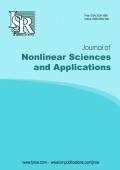Coupling homogenization and large deviations, with applications to nonlocal parabolic partial differential equations
Authors
A. Coulibaly
- Amadou Mahtar Mbow University of Dakar, Dakar, Senegal.
Abstract
Consider the following nonlocal integro-differential operator of Lévy-type \(\mathcal{L}^{\alpha}_{\varepsilon,\delta}\) given by
\[
\mathcal{L}^{\alpha}_{\varepsilon,\delta}f(x):=\int_{\mathbb{R}^{d}\backslash \left\lbrace 0\right\rbrace}\bigg[ f\left( x+\varepsilon\sigma\left(\frac{\scriptstyle x}{\scriptstyle \delta},y\right)\right) - f(x)
-\varepsilon\sigma^{i}\left(\frac{\scriptstyle x}{\scriptstyle \delta},y\right)\partial_{i}f(x)\boldsymbol{1}_{B} (y)\bigg] \nu_{\varepsilon}^{\alpha}(dy)+\left[ \left(\frac{\scriptstyle \varepsilon}{\scriptstyle \delta}\right)^{\alpha-1}b^{i}_{0}\left(\frac{\scriptstyle x}{\scriptstyle \delta}\right)+b^{i}_{1}\left(\frac{\scriptstyle x}{\scriptstyle \delta}\right) \right] \partial_{i}f(x),
\]
related to stochastic differential equations driven by multiplicative isotropic \(\alpha\)-stable Lévy noise (\(1<\alpha<2\)). We study by using homogenization theory the behavior of \(u^{\varepsilon,\delta}:\mathbb{R}^{d}\longrightarrow\mathbb{R}\) of double perturbed Kolmogorov, Petrovskii and Piskunov (KPP)-type with periodic coefficients varying over length scale \(\delta\) and nonlinear reaction term of scale \(1/\varepsilon\),
\begin{equation}\label{eq1}
\left\lbrace
\begin{array}{ll}
\frac{\partial u^{\varepsilon,\delta}}{\partial t}(t,x)=\mathcal{L}^{\alpha}_{\varepsilon,\delta}u^{\varepsilon,\delta}(t,x)+\frac{\scriptstyle 1}{\scriptstyle \varepsilon}f\left(\frac{\scriptstyle x}{\scriptstyle \delta},u^{\varepsilon,\delta}(t,x) \right) , &x\in\mathbb{R}^{d},\ 0<t,\\
u^{\varepsilon,\delta}(0,x)=u_{0}(x), &x\in\mathbb{R}^{d}.
\end{array}
\right.
\end{equation}
The behavior is required as \(\varepsilon,\delta\) both tend to \(0\). Our homogenization method is probabilistic. Since \(\delta\) and \(\varepsilon\) go at the same rate, we may apply the large deviations principle with homogenized coefficients.
Share and Cite
ISRP Style
A. Coulibaly, Coupling homogenization and large deviations, with applications to nonlocal parabolic partial differential equations, Journal of Nonlinear Sciences and Applications, 16 (2023), no. 3, 168--179
AMA Style
Coulibaly A., Coupling homogenization and large deviations, with applications to nonlocal parabolic partial differential equations. J. Nonlinear Sci. Appl. (2023); 16(3):168--179
Chicago/Turabian Style
Coulibaly, A.. "Coupling homogenization and large deviations, with applications to nonlocal parabolic partial differential equations." Journal of Nonlinear Sciences and Applications, 16, no. 3 (2023): 168--179
Keywords
- Homogenization
- large deviations
- nonlocal parabolic PDE
- SDE with jumps
- Feynman-Kac formula
MSC
References
-
[1]
G. Bal, W. Jing, Fluctuations in the homogenization of semilinear equations with random potentials, Comm. Partial Differential Equations, 41 (2016), 1839–1859
-
[2]
P. Baldi, Large deviation for processes with homogenization and applications, Ann. Probab., 19 (1991), 509–524
-
[3]
G. Barles, R. Buckdahn, E. Pardoux, Backward stochastic differential equations and integral-partial differential equations, Stochastics Stochastics Rep., 60 (1997), 57–83
-
[4]
P. H. Baxendale, D. W. Stroock, Large deviations and stochastic flows of diffeomorphisms, Probab. Theory Related Fields, 80 (1988), 169–215
-
[5]
P. Bella, B. Fehrman, J. Fischer, F. Otto, Stochastic homogenization of linear elliptic equations: Higher-order error estimates in weak norms via second-order correctors, SIAM J. Math. Anal., 49 (2017), 4658–4703
-
[6]
A. Bensoussan, J.-L. Lions, G. Papanicolaou, Asymptotic analysis for periodic structures, North-Holland Publishing Co., Amsterdam-New York (1978)
-
[7]
C. L. Bris, F. Legoll, F. Madiot, Multiscale finite element methods for advection-dominated problems in perforated domains, Multiscale Model. Simul., 17 (2019), 773–825
-
[8]
A. Columbu, S. Frassu, G. Viglialoro, Refined criteria toward boundedness in an attraction-repulsion chemotaxis system with nonlinear productions, Appl. Anal., (2023), 1–17
-
[9]
A. Dembo, O. Zeitouni, Large Deviations Techniques and Applications, Jones and Bartlett Publishers, Boston (1993)
-
[10]
L. C. Evans, The perturbed test function method for viscosity solutions of nonlinear PDE, Proc. Roy. Soc. Edinburgh Sect. A, 111 (1989), 359–375
-
[11]
L. C. Evans, Periodic homogenisation of certain fully nonlinear partial differential equations, Proc. Roy. Soc. Edinburgh Sect. A, 120 (1992), 245–265
-
[12]
M. I. Freidlin, R. B. Sowers, A comparison of homogenization and large deviations, with applications to wavefront propagation, Stochastic Process. Appl., 82 (1999), 23–52
-
[13]
M. I. Freidlin, A. D. Wentzel, Random perturbations of dynamical systems, Springer-Verlag, New York (1984)
-
[14]
Q. Huang, J. Duan, R. Song, Homogenization of nonlocal partial differential equations related to stochastic differential equations with L´evy noise, Bernoulli, 82 (2022), 1648–1674
-
[15]
T. Li, S. Frassu, G. Viglialoro, Combining effects ensuring boundedness in an attraction-repulsion chemotaxis model with production and consumption, Z. Angew. Math. Phys., 74 (2023), 21 pages
-
[16]
T. Li, N. Pintus, G. Viglialoro, Properties of solutions to porous medium problems with different sources and boundary conditions, Z. Angew. Math. Phys., 70 (2019), 18 pages
-
[17]
T. Li, G. Viglialoro, Boundedness for a nonlocal reaction chemotaxis model even in the attraction-dominated regime, Differential Integral Equations, 34 (2021), 315–336
-
[18]
´ E. Pardoux, S. Peng, Backward stochastic differential equations and quasi-linear parabolic differential equations, Lect. Notes Control. Inf. Sci., 176 (1992), 200–217
-
[19]
F. Pradeilles, Une m´ethode probabiliste pour l’´etude de fronts d’onde dans les ´equations et syst`emes d’´equation de r´eactiondiffusion, Th`ese de doctorat, Univ. Provence., (1999),

